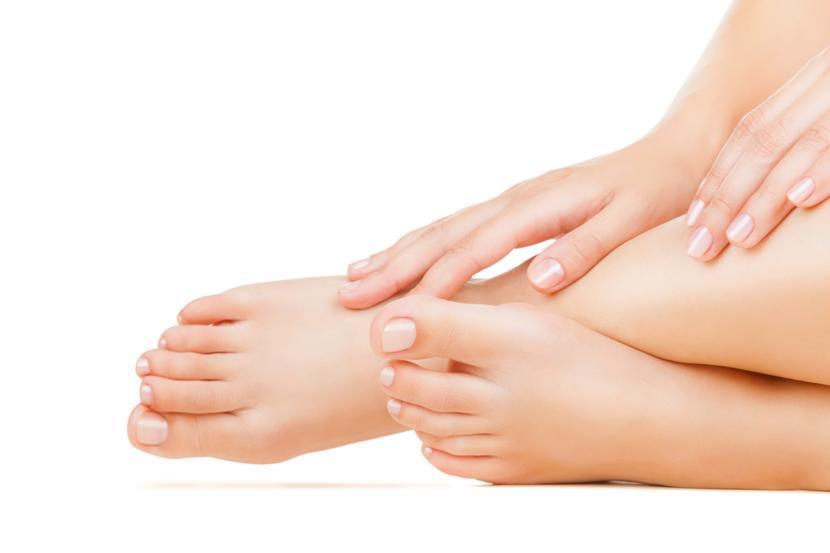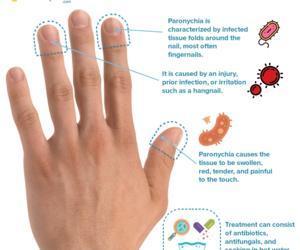Paronychia Treatment

What is paronychia?
Paronychia is a form of skin infection that occurs around the fingernails and toenails. Bacteria, Candida (yeast), or a combination of both microorganisms usually cause this infection.
Paronychia may gradually or suddenly develop depending on the root cause of the infection. Its signs and symptoms are easily detected and treated with minimal to no damage to the nails and skin. However, in severe infections, partial or complete loss of the nail may result.
Types of Paronychia
There are two types of paronychia: acute and chronic. These conditions depend on the causative infecting agent, the speed of onset, and duration of the infection.
- Acute Paronychia - An acute infection usually develops fast and typically occurs in the skin around the fingernails. It is often a result of skin damage around the nails due to physical trauma, manicure treatments, hangnails, nail biting, or picking. The common types of bacteria that can cause acute paronychia are Enterococcus and Staphylococcus.
- Chronic Paronychia - Chronic paronychia slowly develops and usually occurs both in the fingernails and toenails. It tends to last for some weeks and then recurs after some time. A chronic infection usually involves both bacteria and yeast (Candida). Chronic paronychia can be commonly seen in individuals who always wet their skin with water. Excessive and constant soaking in water can strip the cuticle’s natural barrier, which paves the way for bacteria and fungi to grow and multiply under the skin leading to an infection.
Treatment
- Home Remedies - Home remedies can effectively treat mild cases of paronychia. If there is pus under your skin, try soaking the affected area using warm water. Do this remedy several times a day. When you are done, dry the area thoroughly. This remedy will help drain the pus on its own.
- Antibiotics - Antibiotics are usually prescribed for severe infections, and when home remedies fail to work.
- Abscess Draining - This method is done by your healthcare provider to drain fluids or abscesses from the blisters. Abscess draining usually speeds up the healing process as well as relieves discomfort. This procedure can also help avoid the spread of the infection.
Chronic paronychia can be more difficult to treat using home remedies. For this reason, you will need to visit a doctor for a more effective treatment. Doctors usually prescribe antifungal agents to treat the infection. However, surgery may be necessary in severe cases, where your nail is partially or completely removed. An anti-inflammatory topical treatment can also be prescribed by your doctor.
Let’s have a look at other treatment options for paronychia:
1. Oregano Oil
Oregano oil is known to contain antibacterial and antiseptic properties, which help in the removal of pus as well as treat any form of infection. To use oregano oil, apply three to four drops directly to the affected region and the surrounding cuticle. For better results, follow this process twice a day.
2. Tea Tree Oil
Tea tree oil is known to effectively help in treating a lot of skin-related issues. It possesses antiseptic, anti-inflammatory, and antifungal properties. However, tea tree oil must not be directly applied to the affected area. What you need to do is to first mix equal portions of tea tree oil and olive oil and then apply it to the affected nail and the surrounding region. Once applied, massage the area for at least 10 minutes and then leave it as it is. Do this process for two to three times a day.
3. Betel Leaves
Betel leaves are one of the oldest remedies for paronychia. Betel leaves contain antibacterial as well as antifungal properties. To use betel leaves, collect a few leaves and then crush them to make a paste. Now, apply this paste to the affected nail and then cover it with the help of a sterile gauze. Repeat this process on a daily basis and you will surely see good results in just a weeks’ time.
4. Apple Cider Vinegar
Apple cider vinegar is also a popular home remedy used for the treatment of a lot of mild medical conditions. Its acid content is known to help in the killing of harmful microorganisms. To make use of this remedy, you would need to mix equal amounts of both water and apple cider vinegar into a small tub. Now, soak the affected region in this mixture for at least 20 minutes. You would need to repeat this process twice a day to get the best results.
5. Hydrogen Peroxide
Hydrogen peroxide is a type of antiseptic used to sterilize wounds. To clean your wound, apply hydrogen peroxide directly to the affected region. The application of hydrogen peroxide can help clear the pus under the nail.
One or a combination of the above-mentioned remedies can be done to help speed up the healing process. It is also important to have patience and allow home remedies to do its work. The regular and proper application of these home remedies can show effective results soon. However, if such remedies do not work, then it is highly recommended that you see a doctor for a proper diagnosis and suitable treatment.
Protection
It is always best to keep yourself protected to prevent worsening the condition. Keeping the affected area dry can help in a faster recovery. Wear gloves to protect your hands from harsh chemicals. At the same time, ensure to apply barrier creams to keep the area moisturized while the cuticles are healing.
Avoid biting your nails and the cutting or tearing of the cuticles to prevent the occurrence of paronychia. Moreover, do not remove the cuticles when applying artificial nails.
Those who have diabetes should ensure to carefully manage their blood sugar levels. Practice and maintain good hygiene by carrying out the proper handwashing habits. Avoid sharing your towels with other people to prevent the spread of infection.
Outlook
Mild cases of acute paronychia have a good outlook. Such cases can be successfully treated with the least chance to recur. However, when infections are left untreated for a long period of time, it can also take a long time to heal. In severe cases, medical treatment using antibiotics is required.
A chronic infection usually lasts for several weeks to months along with a longer recovery period. For this reason, it is important to treat paronychia early.











